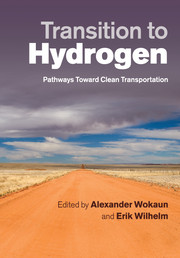Book contents
- Frontmatter
- Contents
- Contributors
- Foreword: on the transition to hydrogen
- Preface
- Executive summary
- Abbreviations
- 1 Introduction
- 2 Life cycle assessment of hydrogen production
- 3 Technical characterisation and multi-criteria analysis of light-duty vehicles
- 4 Hydrogen emissions to the atmosphere from industry and transportation
- 5 Regional fleet simulation
- 6 Long-term scenarios of the global energy and transport system
- 7 Integrated assessment of hydrogen in transportation
- Appendix A Summary of fundamental assumptions
- Appendix B Selected input assumptions, technology descriptions, and heuristics
- Appendix C Characteristics of the present and future vehicle designs
- Appendix D Survey questionnaire and aggregated responses
- Appendix E Assumptions and inputs driving fleet dynamics simulation
- References
- Index
- Plates
5 - Regional fleet simulation
Published online by Cambridge University Press: 05 November 2011
- Frontmatter
- Contents
- Contributors
- Foreword: on the transition to hydrogen
- Preface
- Executive summary
- Abbreviations
- 1 Introduction
- 2 Life cycle assessment of hydrogen production
- 3 Technical characterisation and multi-criteria analysis of light-duty vehicles
- 4 Hydrogen emissions to the atmosphere from industry and transportation
- 5 Regional fleet simulation
- 6 Long-term scenarios of the global energy and transport system
- 7 Integrated assessment of hydrogen in transportation
- Appendix A Summary of fundamental assumptions
- Appendix B Selected input assumptions, technology descriptions, and heuristics
- Appendix C Characteristics of the present and future vehicle designs
- Appendix D Survey questionnaire and aggregated responses
- Appendix E Assumptions and inputs driving fleet dynamics simulation
- References
- Index
- Plates
Summary
Introduction
Deep cuts in global GHG emissions are required to keep the average increase in global temperature below 2°C (IPPC, 2007c; Sokolov et al., 2009). A strong need for action concerning road traffic as a main originator of GHG emissions through their almost exclusive use of fossil energy carriers is acknowledged (Ribeiro et al., 2007), as discussed in previous chapters. In this chapter, we analyse which technological drivetrain pathways and deployment strategies are required to meet the long-term, global challenge posed by climate change. We implicitly assume that the required technology change must be governed and managed by concerted decision making of entrepreneurial and political leaders. Many policy studies address the mid-term impact of incremental, energy-efficiency improvements of conventional ICE, or hybrid technologies and biofuels (Bandivadekar et al., 2008b; Hankey and Marshall, 2009; Meyer and Wessely, 2009). However, a longer term view on fleet dynamics addressing not-yet-regulated policy measures is missing from the literature. Also, most of the fleet models do not discuss the impact of preference changes on the diffusion process of alternative drivetrain technologies and the effectiveness of corresponding policy measures (Greene et al., 2007; McCollum and Yang, 2009; Thomas, 2009).
In this chapter, we present simulation experiments that illustrate the impact of vehicle technology purchase preferences. The system dynamics fleet model developed and used, therefore, offers a long-term view for the EU, addressing the question of what kind of drivetrain technologies have the potential to meet the scientifically indicated, GHG emission targets. Illustrative diffusion scenarios and the CO2 impact of competing drivetrain technologies, including advanced ICE, hybrid technologies, and vehicles fuelled with gaseous fuel (i.e. LPG, CNG) as well as near zero-emission vehicles (i.e. renewable HFCV) are presented.
- Type
- Chapter
- Information
- Transition to HydrogenPathways Toward Clean Transportation, pp. 128 - 176Publisher: Cambridge University PressPrint publication year: 2011



